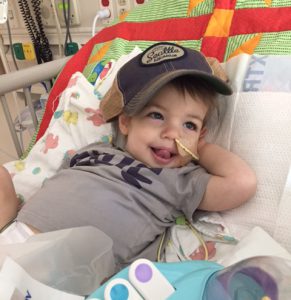
Sara Chenault and her husband, Ed Lang, held their 15-month-old baby, Casey Lang, tightly as they sat outside the hospital on a warm sunny day in July. Casey giggled as he watched the wild rabbits hop through the grass. His eyes lit up and he squealed as he reached for the basketball his dad gently rolled toward him. Casey couldn’t seem happier, but his parents were beside themselves – they were saying goodbye to their baby boy.
“His situation was dire and we didn’t want Casey’s last few hours spent in a hospital room,” said Sara as she tearfully recalls that heartbreaking afternoon. “We wanted our last few hours together to be meaningful so we took Casey outside to let him just enjoy being a little boy.”
Casey and his family had already endured a rollercoaster experience throughout an unexpected 5-week hospital stay. They thought they were nearing the end of their time at the hospital and that Casey may finally be out of the woods. However, that morning everything changed. It became clear the worst was yet to come.
From a fever to urgent surgery
Casey and his family flew from their hometown of San Francisco to Seattle to visit Sara’s parents for Father’s Day this past June. The night before they departed for Seattle, Casey had a fever. Sara and Ed took him to an urgent care in San Francisco just to be sure it wasn’t anything serious. The doctor suggested it was likely a virus and said it was fine to go to Seattle. Once there, Casey’s fever persisted and seemed to get worse, so his parents took him to urgent care once again over Father’s Day weekend. The same diagnosis was given – likely a virus, and they should just keep an eye on it.
By Monday morning when Casey and his family were scheduled to fly home, Casey was inconsolable and his parents noticed his leg was swollen.
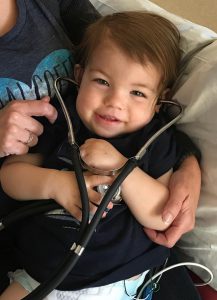 Debating whether to get home to see his pediatrician or delay their flight, they opted to take Casey to Seattle Children’s Emergency Department; a decision Ed said they will never forget and for which they will be “eternally thankful.”
Debating whether to get home to see his pediatrician or delay their flight, they opted to take Casey to Seattle Children’s Emergency Department; a decision Ed said they will never forget and for which they will be “eternally thankful.”
Doctors at Seattle Children’s started Casey on antibiotics immediately. A magnetic resonance imaging (MRI) showed Casey had an extensive infection in his tibia. Dr. Mark Dales, an orthopedic surgeon and chief of the Fracture Clinic and trauma service, delivered the news that he needed surgery right away to clean out the infection in his leg, and Casey was taken to the operating room.
“It was totally unexpected and we were in shock,” Ed said. “We went from thinking he just had a virus and we’d soon be going home, to him needing immediate surgery. Thankfully we made the decision to go to Seattle Children’s and Casey was in the hands of an expert surgeon like Dr. Dales who made us feel as calm as possible in the midst of an entirely surreal experience.”
The surgery seemed to go well, and Casey was taken to the Pediatric Intensive Care Unit (PICU) to recover.
“Because everything happened so suddenly, it wasn’t until we saw him after surgery in the PICU with barely a place on his little body that didn’t have an IV line, tube, or bandage that it really sunk in how truly sick he was,” Sara said.
Within hours, they received the next blow – doctors determined that the bacteria behind the infection in Casey’s body was Methicillin-resistant Staphylococcus aureus (MRSA), an aggressive type of staph bacteria resistant to commonly used antibiotics. They were also told that the infection was spreading quickly and aggressively.
“At first it looked like a routine bone infection, and once we get the infection cleaned out of the bone, kids typically turn a corner,” Dales said. “But it was soon clear that Casey had a widespread infection and he started getting sicker rapidly.”
But this time, the bone was not the culprit. The infection had moved on to attack his heart.
Mending a broken heart
Sara and Ed met cardiologist Dr. Matthew Files who explained that Casey had endocarditis, an infection of the inner layer of the heart. The bacterial infection ate away at his mitral valve, which allows blood to pass from the left atrium (receives blood from the lungs) to the left ventricle (pumps blood out to the body). He would eventually need surgery to fix the failing valve. However, Casey was still too infected to undergo another surgery at that point – or so was the thinking on day two of Casey’s hospital stay.
That night, Sara and Ed awoke to doctors and nurses rushing into to Casey’s room because his heart rate was off the charts.
“It was like a scene from the TV show ‘ER,’” Sara said. “It was terrifying and a gut-wrenching realization of just how serious his situation was becoming.”
By the next morning, Casey’s heart valve was deteriorating so quickly that surgery was necessary that day.
“Within 48 hours we went from Casey having a simple fever, to an infection in the leg, to MRSA and then to needing open heart surgery,” Sara said. “It was becoming very clear how critical of a situation he was in.”
But through the terror of it all, Casey’s parents found comfort from the team at Seattle Children’s.
“Casey’s team brought us into the fold, including us in rounding conversations about his care and ensuring we understood everything that was happening,” Ed said. “We were so impressed with how his care team not only took care of Casey, but they took care of us too, from ensuring we ate to helping us cope with the mental anguish we were experiencing.”
Casey went into heart surgery that day with Dr. Jonathan Chen, chief of pediatric cardiovascular surgery and co-director of the Seattle Children’s Heart Center, performing the operation.
“Casey had a raging infection and we needed to not only fix his heart valve, but also prevent the infection from taking out other key components of the heart,” Chen said.
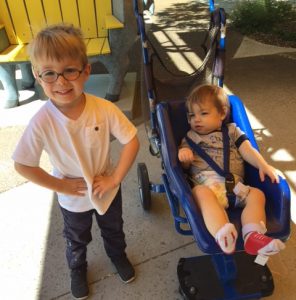
“While we feared we may lose Casey, Dr. Chen made us feel like ‘I got this,’ which gave us confidence,” Ed said. “I can’t stress enough how the combination of clinical expertise and compassion that we experienced at Seattle Children’s made all the difference.”
Casey’s mitral valve was successfully replaced with a mechanical valve, and he was in recovery in the Cardiac Intensive Care Unit (CICU). While his condition changed minute to minute at first, after a week and a half he reached a major milestone in being able to move out of the CICU to the surgical unit.
“We spent the next three weeks monitoring the infection, and eventually Casey was able to go in stroller rides around the hospital and reunite with his 4-year-old brother, Cody, who he hadn’t seen since he checked in,” Sara said. “Things were looking up and we were finally starting to feel at ease.”
The worst-case scenario
On Thursday, July 20, Sara and Ed were preparing to take Casey out for lunch after a routine echocardiogram to check his heart function. Within a few minutes, doctors came rushing in and panic set in.
“It was the absolute worst-case scenario – his heart was coming apart and we were told he had a 75% likelihood of dying,” Sara said. “We were suddenly in crisis again and we were heartbroken. We knew we could have lost him with the first heart surgery, but this time the odds were so much worse.”
Because his heart tissue had been weakened by the infection, Casey had a life-threatening pseudoaneurysm, or a rupture in the wall of his heart; something that no one expected.
“It’s very rare to see kids with perfectly healthy hearts develop endocarditis, and then to develop a pseudoaneurysm is something that is never seen,” Files said.
While they waited anxiously for the surgery, it was at that time Ed asked to take Casey outside to see the rabbits play in the grass, which had become Casey’s favorite past time during his hospital stay. They wanted their last few hours together to be spent doing something Casey loved. When it came time for Casey to go into surgery, Sara and Ed lost it.
“It’s a feeling that’s hard to articulate, like nothing I had ever felt before,” Sara said through tears. “It was the worst feeling of my life – terror, horror, profound sadness – not knowing if I’d ever see him again.”
“We just wanted Casey to know that we loved him, we believed in him and would be there with him through it all,” Ed said. “And also that if it all became too much, we would be by his side through that as well.”
Defying the odds
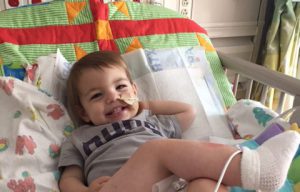 After being faced with the worst-case scenario, Casey’s parents said they were blown away to hear the surgery, performed by cardiothoracic surgeon Dr. Michael McMullan, went “as ideal as possible.” The pseudoaneurysm was fixed with a patch and Casey came out of surgery without needing mechanical life support – something else no one had expected.
After being faced with the worst-case scenario, Casey’s parents said they were blown away to hear the surgery, performed by cardiothoracic surgeon Dr. Michael McMullan, went “as ideal as possible.” The pseudoaneurysm was fixed with a patch and Casey came out of surgery without needing mechanical life support – something else no one had expected.
Over the next few days, Casey had a strong recovery with meticulous care provided by the CICU team and was soon moved back to the surgical unit. He spent a few more weeks in the hospital before being discharged and eventually going home at the end of September, after more than three months.
“It’s a miracle he made it through all that he did, and it was very powerful to see his parents’ bravery,” Chen said. “It was fortunate he was at a hospital with the specialty care that he needed, and he kept surviving these incredible circumstances. The entire team was amazed by his recovery.”
Dales echoed this sentiment and said Casey is “one resilient little guy.”
“He was gravely ill a few times, and we didn’t know if he would make it,” Dales said. “But he not only survived, his recovery was remarkable. One day I saw him toddling down the hall with his mom and I almost didn’t recognize him because he was doing so well. Then I saw him in clinic and he was all over the room playing. It was fantastic to see his complete turnaround.”
Finally coming home
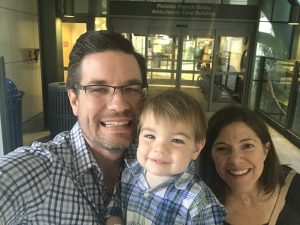
Sara and Ed were happy to finally return home after their vacation took such a terrifying turn.
“Friends and family decorated our house, making coming home feel so warm, and Casey immediately went to his toys,” Sara said. “While we’re a little nervous being away from his care team at Seattle Children’s, we’re hopeful for Casey’s future.”
Now 18 months old, Casey is thriving. He will need two more heart surgeries to have his mechanical heart valve replaced as he grows, but he is back to his normal self.
“Other than the scars, you wouldn’t know anything happened,” Ed said. “We’re so happy that he’s talking, smiling, laughing and throwing temper tantrums like any other kid his age.”
As Casey now sits in his backyard at home with his family, gleefully watching the red and yellow leaves fall from the trees, his parents reflect on how thankful they are.
“We feel so lucky that he is where he is today,” Sara said. “Seattle Children’s saved our son and we don’t ever want to imagine what would have happened if we would have gotten on that plane to go home. Casey proved he is a fighter and we know he has a bright future ahead.”
Resources
- Seattle Children’s Orthopedics and Sports Medicine Program
- Seattle Children’s Heart Center
- Seattle Children’s Infectious Disease and Virology Program
- Seattle Children’s Emergency Department

